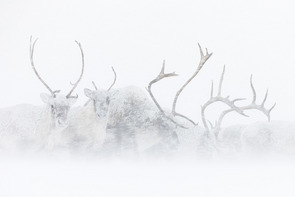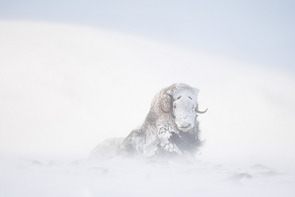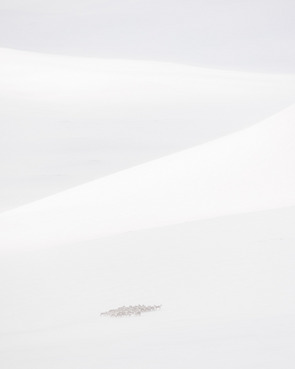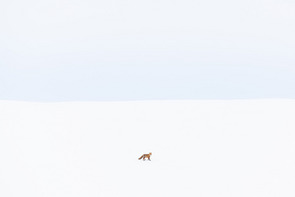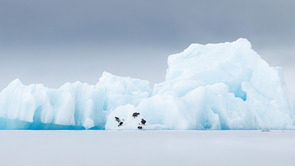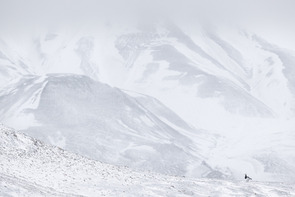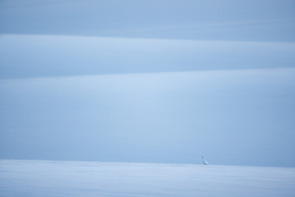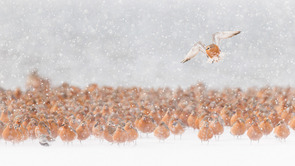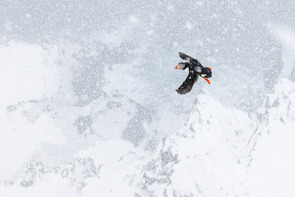Winner: Tobias Gjerde – Norway
Twenty-two-year-old Tobias Gjerde is from Oslo, Norway, and developed a deep passion for wildlife photography at an early age. He fell in love with the Nordic wilderness and, in particular, the cold and inhospitable side of nature. Through his images, Tobias endeavors to convey the captivating beauty of the natural world and highlight the importance of preserving all the wilds that remain.
While studying economics at NTNU in Trondheim, Tobias spends most of his free time outdoors, always with a camera in hand. He is drawn to discovering original and creative approaches to photographing common species just as much as he is fascinated by encounters with rare and elusive species.
In 2023, Tobias served in the Norwegian Army as a combat photographer for the Arctic Ranger Battalion (GSV), allowing him to combine his passion for photography with meaningful military service. In 2024, he became an elected member of Norske Naturfotografer / NN – an association for professional Norwegian nature photographers. In 2025, Tobias focus lies on producing mini-documentaries and behind-the-scenes videos to share wildlife photography stories from the field with his followers on YouTube and Instagram.
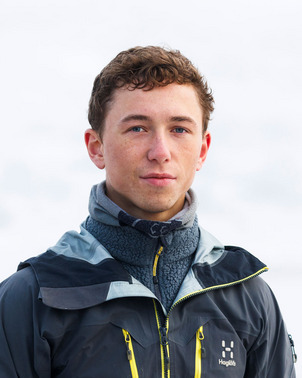
Project: Norwegian winter
There is something truly special about winter in the North. There are days of absolute stillness, when the soft snow muffles all sound. And there are days of deafening wind, when simply standing upright becomes a challenge. The grip of winter is both unforgiving and mesmerisingly beautiful. When the snow blankets the ground, a bare, minimalist landscape emerges, as white as a canvas - a photographer's paradise, a nightmare for wildlife. As temperatures drop and the wind picks up, we humans usually have a choice: stay out in the freezing cold or seek refuge in a warm house, cabin or tent. Animals have no such option. They must endure whatever conditions nature doles out. To survive the extreme challenges of the Norwegian winter, they must be extraordinarily resilient and highly adapted. With my images, I strive to capture this admirable resilience – and do justice to the remarkable creatures that brave the Nordic winter.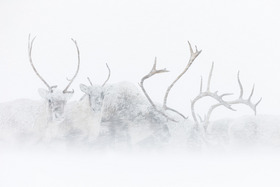 Weathering the storm
Weathering the stormAs winter descended upon the Norwegian mountains, I spent two nights in Nesbyen to photograph wild reindeer (Rangifer tarandus). Within hours, over 30 cm of snow fell and the wind picked up dramatically. I was fortunate to locate a herd before visibility deteriorated completely and then spent three hours in their company. Despite wearing the proper gear, the wind, snow, and sub-zero temperatures took their toll. Although my tent was only six kilometres away, the return journey took more than three hours in the pitch-black winter night through the deep, newly fallen snow. What had seemed a simple hike earlier in the day became a grueling battle through half a metre of snow. This demanding expedition tested both my body and mind and deepened my respect for these mountains and the local wildlife.
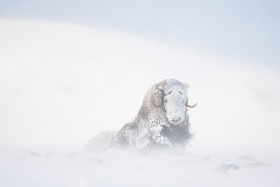
Snow queen
After hiking 15 km in rugged terrain, I needed to traverse a pass to reach the next valley. Battling gale-force winds and dense snow, I looked up and noticed the rocks up ahead moving! First one, then another – and soon, 12 large boulders rose to their feet. The musk oxen (Ovibos moschatus) stared directly at me and I carefully retreated to be able to observe them from a safe distance. It was not long before they settled down once more, blending in perfectly with the snowstorm. An hour later, the heavy clouds briefly parted, revealing the neighbouring peaks. In this very moment, one of the cows rose to her feet. Her body, covered in a dense layer of snow, glistened in the light. She stood with quiet dignity, like a snow queen surveying her vast, windswept realm.
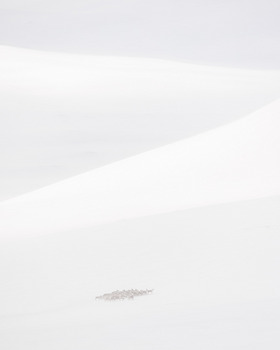 Nomads of the North
Nomads of the NorthOn the second day of a winter expedition to Dovrefjell, I was awakened by strong winds battering my tent. Outside, I was greeted by a total whiteout with close to zero visibility. As I climbed up the mountain, gusts of wind nearly knocked me over, and the snowstorm was so severe that I could barely discern up from down. After traversing a mountain pass, conditions suddenly changed. For a brief moment, the low-hanging clouds parted and the snow drift ceased. I raised my binoculars and scanned the landscape for signs of life. To my surprise, I spotted a herd of wild reindeer (Rangifer tarandus) slowly ascending the slope. Behind them, the rolling hills and rapidly changing light created a gorgeously layered backdrop. Just moments later, the clouds closed in again and visibility was reduced to a minimum as the reindeer continued their silent journey through Norway’s vast and desolate mountains.
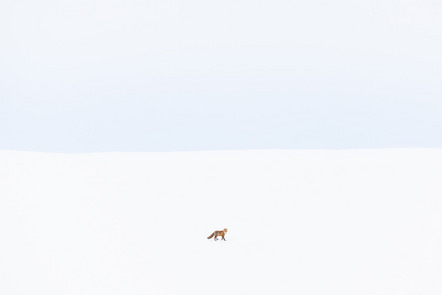
Lone wanderer
During a five-day photo expedition to the Dovrefjell mountains, I snowshoed over 70 km, encountering only a handful of hardy specialists capable of surviving in this unforgiving landscape. One such encounter was the fleeting moment I shared with a red fox (Vulpes vulpes). I spotted the cunning canine a kilometre away and slowly crept up a nearby slope to gain a better vantage point. Once in position, I knelt down and waited, hoping the fox would cross the open, snow-covered section of the hillside. To my great delight, the fox did just that, allowing me to capture an elegantly minimalist portrait of this solitary wanderer.
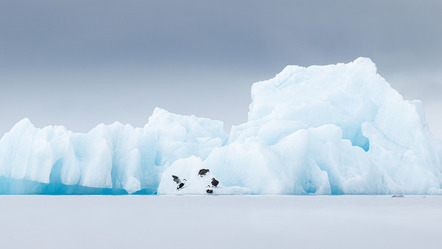
Near Ny-Ålesund, Svalbard, icebergs calve from the glaciers in Kongsfjord and drift out to sea. For common eiders (Somateria mollissima), these icebergs serve as secure and comfortable resting platforms between dives. The dark clouds hanging low over the open water, paired with the glowing blues of the ice, create a beautiful stage on which to portray these sea ducks in their Arctic environment.
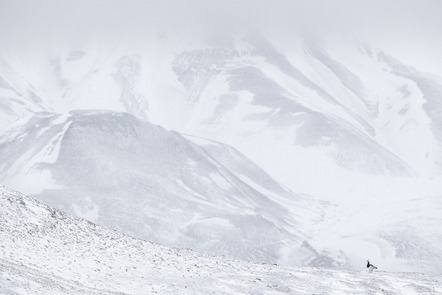
After the snowstorm
Svalbard's barnacle geese (Branta leucopsis) returned to their breeding grounds in May only to be welcomed by a relentless snowstorm. After the wind and snowfall subsided, a monochromatic landscape of intricate textures and complex patterns was revealed. In only a matter of weeks, this rugged, desolate land will be carpeted in fresh green, ushering in a brief period of abundance as the geese introduce their chicks to the Arctic realm.
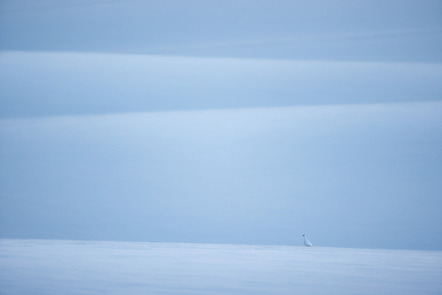
Blue hour on the tundra
May in Arctic Norway and the tundra remains blanketed in snow. The clock strikes midnight as I spot a strange snowball in the distance. A closer look through my binoculars confirms my suspicion: a rock ptarmigan (Lagopus muta). The midnight sun casts its subtle glow, with snow-covered slopes forming parallel lines in the bluish tundra.
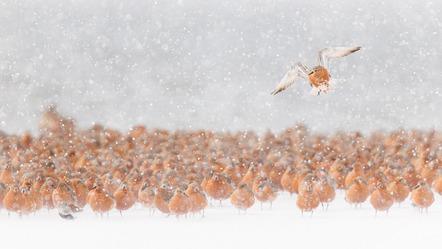
Waiting for spring
These red knots (Calidris canutus) were confronted with the unpredictability of nature during a May snowstorm at a stopover site in northern Norway. Such storms are uncommon but red knots must be prepared for the unexpected during their spring migration north along the Norwegian coast. The Norwegian name for red knot translates to “polar sandpiper” – an appropriate name given the bird’s resilience and remarkable adaptation to the harsh conditions of the Arctic.
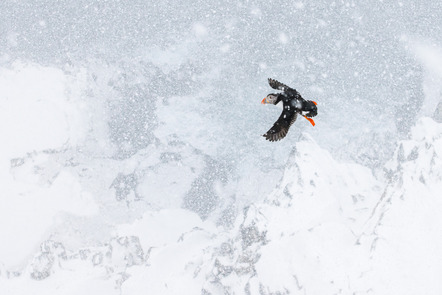
It was March in the Arctic, and the puffins (Fratercula arctica) of Hornøya had just returned to their breeding grounds – by the tens of thousands. But spring was further off than expected, and the birds were caught in severe weather. Snowstorms are not uncommon in the Far North, and these “clowns of the sea” hardly seemed fazed by the Arctic’s fury. As I struggled to remain upright in the gusting wind, the puffins danced effortlessly in the storm, soaring above a jagged landscape of cliffs and treacherous waters. This image not only captures the rawness of the Nordic environment but also offers a new perspective on the resilience of these birds, so often seen as merely cute and comical.
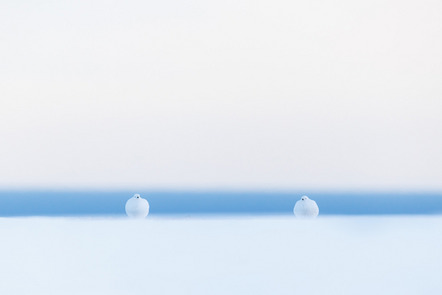
A strip of blue
Rock ptarmigan (Lagopus muta) are typical mountain dwellers. Yet on Varanger, in the far north-east of Norway, where the mountains extend to the coast, these alpine specialists can be observed at the seaside. This opens up unique photographic possibilities. By embracing the emptiness of the landscape and incorporating a narrow strip of open ocean, a highly minimalist and unusual portrait of this species emerged.









